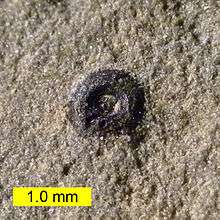Sphenothallus
| Sphenothallus | |
|---|---|
 | |
| Sphenothallus holdfast from the Kope Formation (Upper Ordovician), Gunpowder Creek, Kentucky. | |
| Scientific classification | |
| Kingdom: | Animalia |
| Phylum: | Cnidaria |
| Class: | Staurozoa |
| Order: | †Conulatae |
| Clade: | †Conulariida |
| Genus: | Sphenothallus Hall, 1847 |
Sphenothallus is a problematic extinct genus lately attributed to the conulariids. It was widespread in shallow marine environments during the Paleozoic.[2][4]
Occurrence
Sphenothallus is represented in the Cambrian period in the Kaili biota and the Mount Stephen trilobite beds, where it co-occurs with the similar organisms Cambrorhythium and Byronia.[1] It is known in younger strata in Canada and the USA, surviving at least until the Mississippian.[3]
Ecology
Sphenothallus lived in groups as an opportunist in environments from hardgrounds to soft mud, even if depleted in oxygen.[3] It probably dispersed via larvae.[3]
Notes
- ↑ Earliest, upper Lower Cambrian (Van Iten et al 2002); latest, not referenced; at least to Mississippian
External links
- "Sphenothallus sp.". Burgess Shale Fossil Gallery. Virtual Museum of Canada. 2011.
References
- 1 2 Van Iten, H.; Zhu, M. Y.; Collins, D. (2002). "First Report of Sphenothallus Hall, 1847 in the Middle Cambrian". Journal of Paleontology. 76 (5): 902–905. doi:10.1666/0022-3360(2002)076<0902:FROSHI>2.0.CO;2. ISSN 0022-3360. JSTOR 1307202.
- 1 2 Bodenbender, B. E.; Wilson, M. A.; Palmer, T. J. (1989). "Paleoecology of Sphenothallus on an Upper Ordovician hardground". Lethaia. 22: 217. doi:10.1111/j.1502-3931.1989.tb01685.x.
- 1 2 3 4 Neal, M. L.; Hannibal, J. T. (2000). "Paleoecologic and Taxonomic Implications Ofsphenothallusandsphenothallus-Like Specimens from Ohio and Areas Adjacent to Ohio". Journal of Paleontology. 74 (3): 369. doi:10.1666/0022-3360(2000)074<0369:PATIOS>2.0.CO;2. ISSN 0022-3360.
- ↑ Vinn, O.; Kirsimäe, K. (2015). "Alleged cnidarian Sphenothallus in the Late Ordovician of Baltica, its mineral composition and microstructure". Acta Palaeontologica Polonica. 60: 1001–1008. doi:10.4202/app.00049.2013. Retrieved 2014-06-11.
This article is issued from
Wikipedia.
The text is licensed under Creative Commons - Attribution - Sharealike.
Additional terms may apply for the media files.